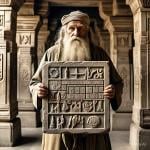THE QUESTION:
Bible trivia: How long is a cubit? What does a shekel weigh? How much does an ephah contain?
THE GUY’S ANSWER:
Readers of the Bible, particularly those wedded to the revered King James Version from four centuries ago, will keep running across esoteric words for weights and measures in ancient times. Many editions today help out by providing modern equivalents in the text or footnotes.
But don’t take those equivalents too literally. Specialist Marvin Powell’s advice is that “measures have always posed a special problem for translators.” He said it’s “almost impossible” to fix equivalents with much precision so we’re talking about rules of thumb — literally the thumb in one example below.
Ancient usage was approximate to begin with, and meanings varied by districts and eras. There appear to be differences before and after Israel’s exile in Babylon that began in 526 B.C., and between the Old and New Testament cultures. Powell figured that any proposed equivalents have a margin of error of plus or minus 5 percent if not more.
This gets us into the development of metrology, the science of measurement. The Guy here relies especially on two historians of the ancient world, Powell of Northern Illinois University, writing in the Anchor Bible Dictionary, and D.J. Wiseman of the University of London, in the New Bible Dictionary.
Consider the Old Testament prophet Amos, who denounced corner-cutters who “trample on the needy” by dishonestly selling wheat so as to “make the ephah small and the shekel great” (8:5). That indicates measurements were inherently a bit flexible as tradesmen bargained over weights and prices in their ancient marketplaces.
The most frequent such term in the Bible is the famous “cubit,” which measured length. Consider the tiny type in the aptly named Strong’s Exhaustive Concordance (“Strong’s for the strong,” as seminarians joke about this 1,340-page doorstopper). The Guy eyeballed the list and looks like cubit appears in maybe a couple hundred King James verses.
The concept of cubit originated as the length of an average forearm from elbow tip to fingertips. Ah, but whose arms, and who had the power to figure the average? A cubit is thought of crudely as about half a yard or meter, say around 18 inches. But there was also the “long cubit,” which meant something like 21 inches. Likewise, a “span” was the spread of an open hand from thumb tip to farthest fingertip, and a “handbreadth” was the width of four fingers at their base excluding the thumb.
The cubit was so standard that instead of the equivalent of our mile or kilometer we have biblical verses like Ezekiel 45:1, which designated the holy district around the Jerusalem Temple at “25,000 cubits long and 30,000 cubits broad.” Within that sector, a square plot for the sanctuary measured “500 by 500 cubits.” Must have been quite the task to plot out these compounds cubit by cubit.
The Bible’s terms for measuring capacity were the following, in descending order of size: kor, homer, letech, ephah, bath, seah, hin, kab, issaron, omer, and log. Sometimes the words were used for only dry or only liquid measuring, and sometimes for both. The primary unit was the ephah (found in 31 King James verses, according to Strong’s), which meant something like a bushel, or with liquids perhaps three dozen liters.
With weight, the Bible used the following terms, also in descending order: talent, mina, shekel, pim, beka, and gerah. The talent originated as the load a typical man had the strength to carry. Shekel, the most frequently used term, wes reckoned at roughly half an ounce, maybe less. This has become the name for currency used in modern-day Israel.
Then there’s measurement of time. A number of Bible passages (see for example Genesis 30:36 or Numbers 11:31) speak of “a day’s journey.” The phrase was inexact but gave the general idea. But was that different from the “Sabbath day’s journey” in Acts 1:12? Each day’s times were depicted as the round of sunrise, then the first through 11th hours (see Matthew 30:3 and 9), sunset, and the first, second, third, and fourth watches of the night, each running three hours.
The Guy will skip past the fathom, finger, reed, furlong, stadion, and metretes, and the values for biblical coins such as the denarius, drachma, and — adding to the confusion — the highly valuable “talent.”
Just for fun, check out https://biblehub.com/weights-and-measures and its listing of 39 measurements with Bible references and links to a handy calculator that converts each term into modern approximations.












